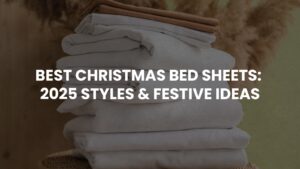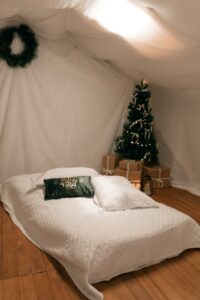Medieval Wedding Bedding Ceremonies
Medieval Wedding Bedding Ceremonies were public, ritualized acknowledgments of marriage—blending law, faith, and tradition to secure legitimacy and honor custom. In noble households, they became elaborate affairs, while commoners often marked them with modest gestures or skipped them entirely. You can see echoes of these traditions in blessings, toasts, and rituals that survive in modern weddings. For a broader context, explore our History of Sleep Traditions guide.
Key Takeaways
- Legal and symbolic purpose: Confirmed the union’s validity for inheritance and social standing.
- Lavish among nobility, modest or absent among commoners.
- Religious blessings marked the transition from ceremony to intimacy.
- Declined as privacy and romantic love replaced communal witnessing.
- Medieval Wedding Bedding Ceremonies still echo today through blessings, toasts, and symbolic gestures.
1. What Were These Medieval Bedding Rituals?
These medieval bedding rituals marked the transition from vows to marital life. Marriage was often a contract, and such customs provided communal proof of legitimacy. Nobles relied on them to protect dynastic claims, while commoners sought local recognition.
Imagine the scene: guests with candles escort the couple to their chamber. Elders or clergy offer blessings at the doorway. Contrary to popular myths, once the threshold was crossed, privacy reigned.
2. Why Medieval Wedding Bedding Ceremonies Mattered
These customs blended practical and symbolic roles. Legitimacy of heirs hinged on recognized consummation. Community presence not only reinforced social bonds but also served as a safeguard of the union’s validity.
- Legal proof: Crucial for succession disputes among nobles.
- Community validation: Recognition cemented the marriage in memory.
- Religious endorsement: Blessings tied the act to divine authority.
3. Variations Across Social Strata
Social class shaped the ceremony’s scale. Nobility hosted grand processions, musicians, and clergy. Peasants often marked the event with a toast or skipped it entirely, valuing modesty over spectacle.

Comparison of practices
- Procession
- Nobility: Lavish with music and attendants.
- Commoners: Simple or none at all.
- Blessings
- Nobility: Clergy-led with scripture.
- Commoners: Family elders with a brief prayer.
- Community Role
- Nobility: Essential for dynastic proof.
- Commoners: Informal, localized recognition.
- Privacy
- Nobility: Ensured after the threshold moment.
- Commoners: Immediate once guests withdrew.
4. Ritual Elements Inside the Ceremony
Across regions, these ceremonial bedding practices followed recognizable steps that signaled the shift from public celebration to private union.
- Ceremonial procession: Guests leading the couple with music or chant.
- Blessings: Given by clergy or elder relatives.
- Threshold moment: Crossing into the chamber signaled consummation’s inevitability.
- Guest withdrawal: After symbolic gestures, the room was cleared.

5. Role of Witnesses and Legal Formalities
Witnesses acted as legal safeguards. Their presence could resolve disputes about a marriage’s legitimacy—especially important for noble families where rival claims were common.
6. Religious Involvement
The Church framed marriage as a sacrament completed by consummation. Priests blessed the couple, sometimes sprinkling holy water or reading scripture, and then departed promptly.

As National Sleep Foundation notes, sleep and marriage traditions were historically linked to ritual and faith.
7. Decline of the Tradition
From the 17th century onward, values shifted toward romantic love and privacy. With nuclear families replacing extended households, these public bedding rites faded from common practice.
8. Modern Echoes in Wedding Traditions
Though the spectacle disappeared, traces remain in symbolic gestures that bridge community celebration and private union.
- Prayers or blessings before the wedding night.
- Toasts wishing the couple prosperity.
- Decorating the bed with fertility symbols or gifts.
9. Bedroom Rituals Around the World
Many cultures retain bedroom-related customs reminiscent of historic wedding night rituals:
- East Asia: “Bedding day” with blessings and reflection.
- South Asia: Rituals invoking deities and family blessings.
- Middle East: Traditions including symbolic gifts and feasts.

Final Thoughts
These traditions reflected a world where marriage was both personal and political. Though the rituals have faded, their influence lingers in blessings, toasts, and cultural practices that honor intimacy and community.
FAQ
Were couples watched during Medieval Wedding Bedding Ceremonies?
No. Guests escorted the couple and witnessed the threshold moment before leaving.
Did peasants have these rituals?
Rarely. Nobles practiced elaborate customs; peasants often skipped them.
Was clergy presence mandatory?
Not always. In some regions, only family elders blessed the couple.
Why did the custom decline?
Privacy and romantic love gradually replaced public witnessing of marriage consummation.
Related reading from Cozy Bed Quarters
- Exploring Modern Bed Types: A Comprehensive Guide
- Stylish Bed Frames to Elevate Your Bedroom Decor
- Gold Canopy Bed: Elegant Luxury
Other reading we found popular
- Architectural Digest – Duvet vs Comforter
- Sleep Foundation – Sleep & Rituals
- EachNight – Bedroom Traditions Across Cultures























